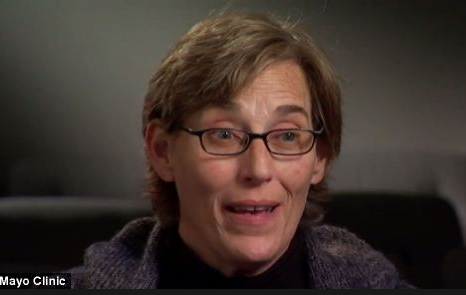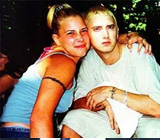

Her name is Stacy Erholtz. For years, the 50-year-old mom from Pequot Lakes, Minn., battled myeloma, a blood cancer that affects bone marrow. She had few options left.
She had been through chemotherapy treatments and two stem cell transplants. But it wasn’t enough. Soon, scans showed she had tumors growing all over her body.
One grew on her forehead, destroying a bone in her skull and pushing on her brain. Her children named it Evan, her doctor said. Cancer had infiltrated her bone marrow.
A nurse uses a syringe to prepare an injection of the combined Measles Mumps and Rubella (MMR) vaccination at an MMR drop-in clinic in 2013.
So, as part of a two-patient clinical trial, doctors at the Mayo Clinic injected Erholtz with 100 billion units of the measles virus – enough to inoculate 10 million people.
Her doctor said they were entering the unknown.
Five minutes into the hour-long process, Erholtz got a terrible headache. Two hours later, she started shaking and vomiting. Her temperature hit 105 degrees, Stephen Russell, the lead researcher on the case, told The Washington Post early Thursday morning.
“Thirty-six hours after the virus infusion was finished, she told me, ‘Evan has started shrinking,’” Russell said. Over the next several weeks, the tumor on her forehead disappeared completely and, over time, the other tumors in her body did, too.
Russell said he and his team had engineered the virus to make it more suitable for cancer therapy. And, after just one dose of it, Erholtz’s cancer went into remission. She has been completely cleared of the disease, Russell wrote in Mayo Clinic Proceedings. Though, in this trial, the treatments were successful on only one of the two patients.
And Tanios Bekaii-Saab, a researcher at James Cancer Hospital and Solove Research Institute in Ohio, said the study must be confirmed in large randomized clinical trials — where many hopes get dashed, the Minneapolis Star Tribune reported.
“Unless we get to the third stage of development, we are cautiously optimistic,” he said.
According the clinic’s statement released Wednesday:
In a proof of principle clinical trial, Mayo Clinic researchers have demonstrated that virotherapy — destroying cancer with a virus that infects and kills cancer cells but spares normal tissues — can be effective against the deadly cancer multiple myeloma. …
Oncolytic virotherapy — using re-engineered viruses to fight cancer — has a history dating back to the 1950s. Thousands of cancer patients have been treated with oncolytic viruses from many different virus families (herpes viruses, pox viruses, common cold viruses, etc.). However, this study provides the first well-documented case of a patient with disseminated cancer having a complete remission at all disease sites after virus administration.
“What this all tells us is something we never knew before – we never knew you could do this in people,” Russell said. “It’s a very important landmark because now we know it can happen. It’s a game changer. And I think it will drive a development in the field.”
The Star Tribune explained how it works:
[Viruses] bind to tumors and use them as hosts to replicate their own genetic material; the cancer cells eventually explode and release the virus. Antiviral vaccines that have been rendered safe can produce the same effects and can also be modified to carry radioactive molecules to help destroy cancer cells without causing widespread damage to healthy cells around the tumors. The body’s immune system then attacks any remaining cancer that carries remnants of the vaccine’s genetic imprint.
Russell said the trial taught the medical researchers two things: “No. 1, you need a really big dose and No. 2, the patient needs to not have an antibody to the virus.”
Russell said the treatment worked in Erholtz, whose tumors were mostly in her bone marrow. However, it was unsuccessful in the other patient, whose tumors were mainly in her leg muscles, the Star-Tribune reported. He said more research is needed to know how the nature of the tumor affects the virus.
For now, once the vaccine has been administered, the body’s immune system will recognize it the second time and attack it. Russell said an upcoming clinical trial will look at breaking down the immune system before treatment.
Also, many people have had the vaccine, though, Russell said patients with myeloma often have weakened immune systems, which can allow the virus to work anyway.
Eventually, this type of technique could become a standardized treatment for cancers such as myeloma or pancreatic cancer, Saab said.
The next step for this method is another clinical trial, which is expected to launch by September, to see if the massive measles dose works on a large number of patients.
Other such trials are going on across the country, such as the NeuVax clinical trial for patients at risk for breast cancer recurrence. Another one, which is run by the Providence Cancer Center, will use bacteria instead of viruses to treat glioblastoma, a type of common brain cancer, according to Medical Daily.
As for Erholtz, her next step is an annual checkup next month, but she’s optimistic.
“We don’t let the cancer cloud hang over our house, let’s put it that way, or we would have lived in the dark the last 10 years,” Erholtz told the Star Tribune.



















